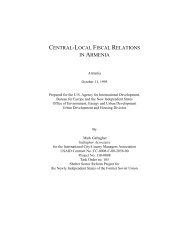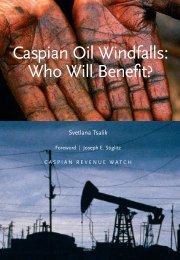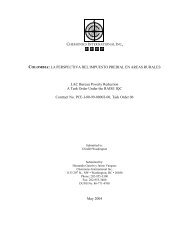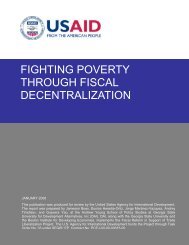Effectiveness and Economic Impact of Tax Incentives in the SADC ...
Effectiveness and Economic Impact of Tax Incentives in the SADC ...
Effectiveness and Economic Impact of Tax Incentives in the SADC ...
You also want an ePaper? Increase the reach of your titles
YUMPU automatically turns print PDFs into web optimized ePapers that Google loves.
INVESTMENT TAX INCENTIVES IN THE <strong>SADC</strong> REGION A-13<br />
•<br />
•<br />
<strong>Tax</strong> holidays for 5 years are also available to new bus<strong>in</strong>esses <strong>in</strong> manufactur<strong>in</strong>g <strong>in</strong>dustries<br />
that are not already present <strong>in</strong> Swazil<strong>and</strong>, <strong>and</strong> which predom<strong>in</strong>antly produce for export.<br />
These holidays are also subject to <strong>the</strong> approval <strong>of</strong> <strong>the</strong> M<strong>in</strong>ister <strong>of</strong> F<strong>in</strong>ance. Income <strong>in</strong> excess<br />
<strong>of</strong> a formula-based limit is still subject to tax dur<strong>in</strong>g <strong>the</strong> holiday period.<br />
Accelerated depreciation <strong>and</strong> additional <strong>in</strong>itial capital allowances <strong>of</strong> 50 percent are provided<br />
for <strong>in</strong>dustrial build<strong>in</strong>gs for manufactur<strong>in</strong>g, mach<strong>in</strong>ery <strong>and</strong> equipment for manufactur<strong>in</strong>g,<br />
<strong>in</strong>frastructure <strong>in</strong>vestments, <strong>and</strong> hotels. A 20 percent <strong>in</strong>itial allowance applies to <strong>the</strong><br />
construction <strong>of</strong> employee hous<strong>in</strong>g <strong>and</strong> farm build<strong>in</strong>gs.<br />
O<strong>the</strong>r tax <strong>in</strong>centives <strong>in</strong>clude a double deduction for approved employee tra<strong>in</strong><strong>in</strong>g expenses <strong>in</strong><br />
designated <strong>in</strong>dustries, <strong>and</strong> a 133-150 percent deduction for expenses <strong>in</strong>curred by h<strong>and</strong>icraft<br />
<strong>and</strong> cottage <strong>in</strong>dustries to <strong>in</strong>crease exports.<br />
The fiscal position <strong>in</strong> Swazil<strong>and</strong> is fairly good. <strong>Tax</strong> revenues have averaged more than 25<br />
percent <strong>of</strong> GDP, with SACU receipts account<strong>in</strong>g for about half <strong>of</strong> <strong>the</strong> total. Company tax<br />
amounts to about 8 percent <strong>of</strong> government revenue, or 2 percent <strong>of</strong> GDP, which is a very low<br />
effective tax rate. The budget deficit has been runn<strong>in</strong>g at 4−5 percent <strong>of</strong> GDP <strong>in</strong> <strong>the</strong> past two<br />
years.<br />
Tanzania 124<br />
The aim <strong>of</strong> Tanzania’s tax <strong>in</strong>centive programs is to attract productive <strong>in</strong>vestment, create<br />
employment <strong>and</strong> enhance exports. The Tanzania Investment Act <strong>of</strong> 1997 provides <strong>the</strong> basic<br />
framework for <strong>in</strong>vestment promotion, though associated tax measures are <strong>in</strong>corporated <strong>in</strong>to<br />
<strong>the</strong> respective tax legislation. The ma<strong>in</strong> change <strong>in</strong> 1997 was to end <strong>in</strong>come tax holidays<br />
outside <strong>of</strong> export process<strong>in</strong>g zones, <strong>in</strong> favor <strong>of</strong> expens<strong>in</strong>g <strong>of</strong> capital assets <strong>and</strong> remission from<br />
customs duty on capital goods for holders <strong>of</strong> a Certificate <strong>of</strong> Investment from <strong>the</strong> Tanzania<br />
Investment Center.<br />
The <strong>in</strong>vestment regime dist<strong>in</strong>guishes two ma<strong>in</strong> categories <strong>of</strong> beneficiaries: lead sectors <strong>and</strong><br />
priority sectors. Lead sectors <strong>in</strong>clude agriculture, m<strong>in</strong>erals, economic <strong>in</strong>frastructure, tourism,<br />
<strong>and</strong> petroleum <strong>and</strong> gas, while priority sectors are manufactur<strong>in</strong>g, natural resources such as<br />
fisheries <strong>and</strong> forestry, aviation, commercial build<strong>in</strong>g, f<strong>in</strong>ancial services, transport,<br />
broadcast<strong>in</strong>g, human resource development, <strong>and</strong> exports. <strong>Incentives</strong> apply equally to<br />
qualify<strong>in</strong>g domestic <strong>and</strong> foreign <strong>in</strong>vestors.<br />
Lead sectors qualify for a 50 percent capital allowance (reduced from 100 percent <strong>in</strong> 2002),<br />
with accelerated write-<strong>of</strong>f <strong>of</strong> <strong>the</strong> rema<strong>in</strong>der, <strong>and</strong> a reduced 10 percent withhold<strong>in</strong>g tax on<br />
dividends (0 percent for m<strong>in</strong>eral companies <strong>and</strong> economic <strong>in</strong>frastructure companies). They<br />
124 Supplementary sources <strong>in</strong>clude <strong>in</strong>formation provided by tax subcommittee; Budget Speech 2003/2004;<br />
PWC Budget 2003 report; IMF country reports 02/1 <strong>and</strong> 03/2, 2003.











